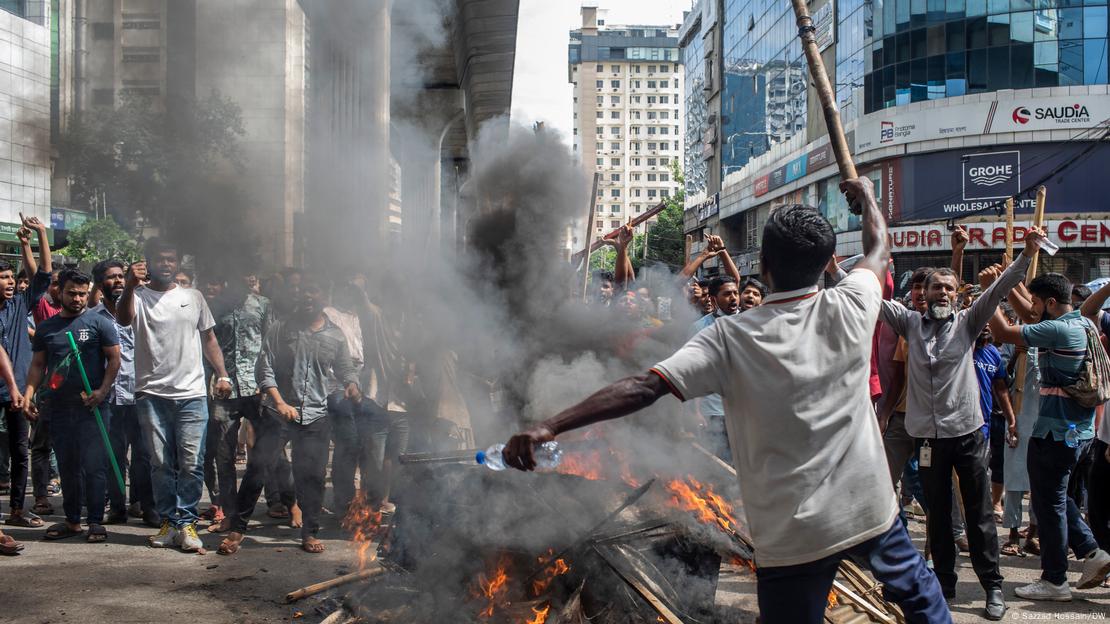
Thousands of Bangladeshi protesters stormed the palace of Prime Minister Sheikh Hasina in the capital, Dhaka on Monday, a day after dozens of people were killed in violent unrest.
Bangladesh’s Channel 24 broadcast images of crowds running into the premier’s official residence in the capital, waving to the camera as they celebrated.

Protesting students had called for a march to the capital on Monday in defiance of a nationwide curfew.
The South Asian country has seen rallies that began last month as resistance to civil service job quotas metamorphose into some of the worst unrest seen during the 15-year rule of the 76-year-old Hasina, who returned to power for a fourth consecutive term in January in a vote boycotted by her main opponents.
This comes as a source close to Hasina said the prime minister and her sister had sought refuge outside the capital.
“She and her sister have left Ganabhaban (the premier’s official residence) for a safer place,” the source told AFP news agency. “She wanted to record a speech. But she could not get an opportunity to do that.”
Some media outlets are reporting that Hasina has resigned.
The country’s leading Bengali-language daily newspaper, Prothom Alo, has reported that almost 100 people, including at least 14 police officers, died in clashes in Dhaka on Sunday, with some media estimates putting the death toll much higher.
The military has imposed a curfew that went into effect on Sunday night covering Dhaka and several other regions.
The government has also declared a holiday from Monday to Wednesday. Mobile internet services have been cut off, and Facebook and messaging apps, including WhatsApp, cannot be accessed.
According to reporters from the AFP news agency, soldiers and police in the capital have set up barbed-wire barricades on routes to Hasina’s office.
In addition, the country’s more than 3,500 garment factories — a major and economically vital industry in Bangladesh — have been shut.
A group of retired military officers has, however, urged Hasina to withdraw troops from the streets and undertake “political initiatives” to resolve the crisis.

Protests have often turned violent, with dozens of people killed over the weekend
Why are people protesting?
The protests have their roots in student-led rallies calling for the end to a quota system, under which 30% of government jobs were reserved for the families of veterans who fought in Bangladesh’s war of independence against Pakistan in 1971.
Although the government has accepted a Supreme Court ruling last month that the veterans’ quota must be cut to 5%, with 93% of jobs to be allocated on merit, protests have continued, partly against what many see as a disproportionate use of force by authorities.
Several hundred are people believed to have been killed in clashes since the unrest began.
Protesters are also calling for an end to Hasina’s rule, with her government accused by rights groups of misusing state institutions to keep hold of power and of cracking down on dissent.
Hasina’s ruling Awami League party, for its part, has said the transformation of the rallies into broader anti-government protests shows that the protests have been appropriated by the main opposition Bangladesh Nationalist Party and the now-banned Jamaat-e-Islami party.
At least 11,000 people have been arrested.
—–
Explore the world of impactful news with CitiNewsroom on WhatsApp!
Click on the link to join the Citi Newsroom channel for curated, meaningful stories tailored just for YOU: https://whatsapp.com/channel/0029VaCYzPRAYlUPudDDe53x
No spam, just the stories that truly matter! #StayInformed #CitiNewsroom #CNRDigital
Read Full Story






















Facebook
Twitter
Pinterest
Instagram
Google+
YouTube
LinkedIn
RSS